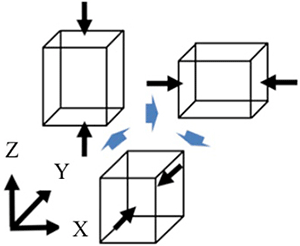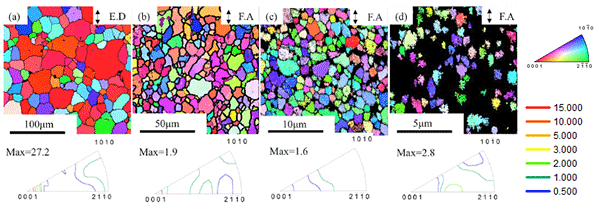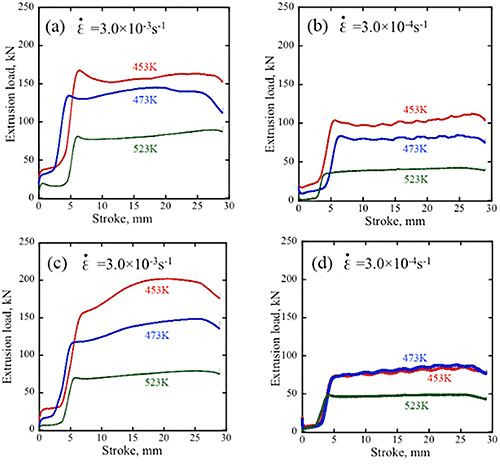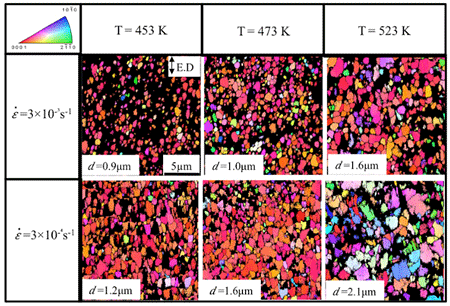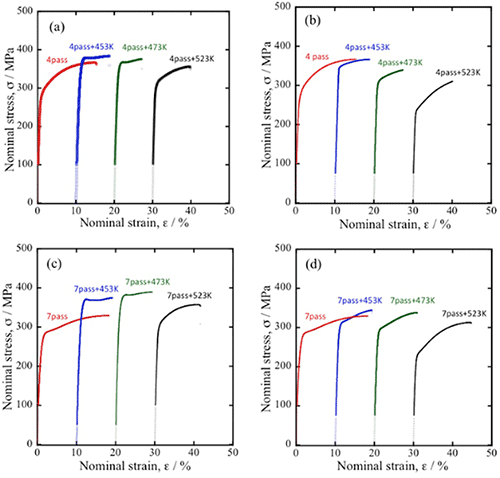Rectangular-shaped AZ80Mg alloy was multi-directionally forged at decreasing temperature conditions from 623 K down to 433 K at an initial strain rate of 3.0 ![]() 10-3 s-1 to a cumulative strain of ΣΔε = 5.6 at maximum (Fig. 1). By multi-directional forging, Mg alloys with having various average grain sizes from 0.7 µm to 26.0 µm were prepared (Fig. 2). Then, the multi-directionally forged Mg alloys were further extruded using dies at temperatures between 453 K and 523 K at initial strain rates of 3.0
10-3 s-1 to a cumulative strain of ΣΔε = 5.6 at maximum (Fig. 1). By multi-directional forging, Mg alloys with having various average grain sizes from 0.7 µm to 26.0 µm were prepared (Fig. 2). Then, the multi-directionally forged Mg alloys were further extruded using dies at temperatures between 453 K and 523 K at initial strain rates of 3.0 ![]() 10-4 s-1 and 3.0
10-4 s-1 and 3.0 ![]() 10-3 s-1 to form plates. The change in the extrusion stress depending on ram stroke was measured and the results were exhibited in Fig. 3. After showing yield stresses soon after the beginning of extrusion, the flow stress first gradually and, then, rapidly increased with ram stroke. The rapid increase in the extrusion stress should be due to increase in the contact area of Mg alloy and die wall. After that, it looked almost saturated because of full contact between Mg alloy and die wall, and at that time, Mg was actually being extruded. The extrusion stress tended to increase with increasing strain rate and decreasing temperature. It is interesting to find that evidently larger strain-rate and temperature sensitivities of the extrusion stress were observed in the finer grain sized samples. Presumably, this should be due to extensive occurrence of grain-boundary sliding during extrusion. At some conditions, the values of strain rate sensitivity of loading stress became more than 0.3, which indicates occurrence of superplasticity. Grain-boundary sliding, which dominates superplasticity, occurs more extensively at conditions of lower strain rate and higher temperature. This analysis confirmed that effect of grain-boundary sliding enabled the warm temperature extrusion of the ultrafine-grained AZ80Mg alloys. This indicates that superplasticity in the ultrafine-grained Mg alloys can take place at conditions of rather higher strain rate and lower temperature than the conventional ones. In such conditions, where lower strain rate, higher temperature and ultrafine-grained structure, slight gain coarsening was also observed (Fig. 4).
10-3 s-1 to form plates. The change in the extrusion stress depending on ram stroke was measured and the results were exhibited in Fig. 3. After showing yield stresses soon after the beginning of extrusion, the flow stress first gradually and, then, rapidly increased with ram stroke. The rapid increase in the extrusion stress should be due to increase in the contact area of Mg alloy and die wall. After that, it looked almost saturated because of full contact between Mg alloy and die wall, and at that time, Mg was actually being extruded. The extrusion stress tended to increase with increasing strain rate and decreasing temperature. It is interesting to find that evidently larger strain-rate and temperature sensitivities of the extrusion stress were observed in the finer grain sized samples. Presumably, this should be due to extensive occurrence of grain-boundary sliding during extrusion. At some conditions, the values of strain rate sensitivity of loading stress became more than 0.3, which indicates occurrence of superplasticity. Grain-boundary sliding, which dominates superplasticity, occurs more extensively at conditions of lower strain rate and higher temperature. This analysis confirmed that effect of grain-boundary sliding enabled the warm temperature extrusion of the ultrafine-grained AZ80Mg alloys. This indicates that superplasticity in the ultrafine-grained Mg alloys can take place at conditions of rather higher strain rate and lower temperature than the conventional ones. In such conditions, where lower strain rate, higher temperature and ultrafine-grained structure, slight gain coarsening was also observed (Fig. 4).
The extruded samples were tensile tested at room temperature and the flow curves are shown in Fig. 5. The as-multi-directionally forged samples to ΣΔε = 3.2 and ΣΔε = 5.6 were also tensile tested and the flow curves are displayed for comparison in Fig. 5. The as-multi-directionally forged samples to ΣΔε = 3.2 and ΣΔε = 5.6 possess good balance of mechanical properties of yield strength of 275 MPa and 305 MPa, ultimate tensile strength of 396 MPa and 390 MPa, ductility of 13 % and 15 %, respectively. They are much higher than those of the as-hot extruded samples, of course excepting ductility, yield strength of 177 MPa, ultimate tensile strength of 320 MPa and ductility 17 %. Therefore, the tensile strength of AZ80Mg alloy was improved significantly by multi-directional forging and without spoiling ductility. This was induced mainly by ultrafine-grained structure and room temperature grain-boundary sliding. In summary, strengthening after extrusion should be caused possibly by combined effects of i) further grain refinement due to dynamic recrystallization, ii) sharp basal texture evolution, iii) dynamic age hardening and iv) work hardening. From the above warm extrusion tests, high strength Mg alloy plates could be successfully produced, therefore, possibility of extrusion of ultrafine-grained Mg alloys with specific high strength at room temperature by employing a mechanism of superplasticity was suggested.
